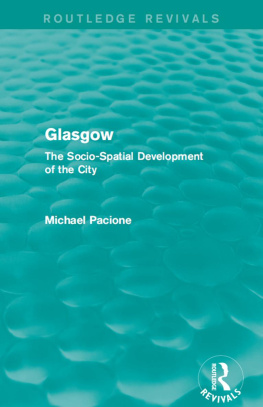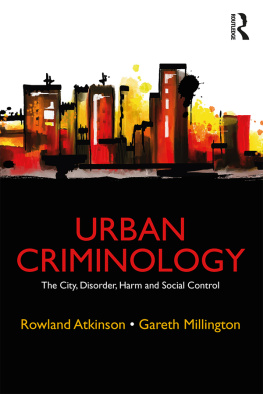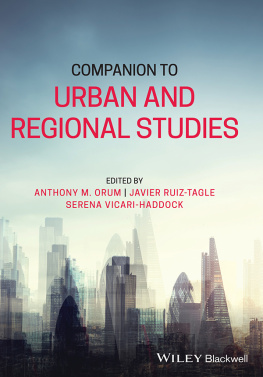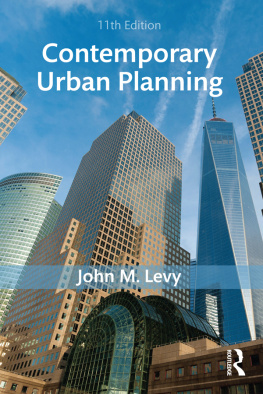Routledge Revivals
Urban Problems
Urban problems and their resolution represent one of the major challenges for planners and decision makers in the modern world. This book, first published in 1990, makes a major contribution to the field, presenting an international and interdisciplinary approach to the challenges presented by the urban environment. The coverage is comprehensive, ranging from the economic and political dimensions of the capitalist system, to the issues of poverty and deprivation and questions about housing equity. This is an essential reference guide to social, economic and environmental problems in urban areas, which is of great value to students of planning, urban studies, geography and sociology.
First published 1990
by Routledge
This edition first published in 2013 by Routledge
2 Park Square, Milton Park, Abingdon, Oxon, OX14 4RN
Simultaneously published in the USA and Canada
by Routledge
711 Third Avenue, New York, NY 10017
Routledge is an imprint of the Taylor & Francis Group, an informa business
1990 Michael Pacione
All rights reserved. No par t of this book may be reprinted or reproduced or utilised in any form or by any electronic, mechanical, or other means, now known or hereafter invented, including photocopying and recording, or in any information storage or retrieval system, without permission in writing from the publishers.
Publishers Note
The publisher has gone to great lengths to ensure the quality of this reprint but points out that some imperfections in the original copies may be apparent.
Disclaimer
The publisher has made every effort to trace copyright holders and welcomes correspondence from those they have been unable to contact.
A Library of Congress record exists under LC control number: 81004455
ISBN 13: 978-0-415-70764-0 (hbk)
ISBN 13: 978-1-315-88665-7 (ebk)
First published 1990
by Routledge
11 New Fetter Lane, London EC4P 4EE
Simultaneously published in the USA and Canada
by Routledge
a division of Routledge, Chapman and Hall, Inc.
29 West 35th Street, New York, NY 10001
1990 Michael Pacione
Phototypeset in lOpt Times by
Mews Photosetting, Beckenham, Kent
Printed and bound in Great Britain by
Biddies Ltd, Guildford and Kings Lynn
All rights reserved. No part of this book may be reprinted or reproduced or utilized in any form or by any electronic, mechanical, or other means, now known or hereafter invented, including photocopying and recording, or in any information storage or retrieval system, without permission in writing from the publishers.
British Library Cataloguing in Publication Data
Pacione, Michael
Urban problems: an applied urban analysis.
1. Capitalist countries. Urban regions. Social planning
I. Title
307.12091732
ISBN 0-415-01392-5
Library of Congress Cataloging-in-Publication Data
Pacione, Michael.
Urban problems: an applied urban analysis / Michael Pacione.
p. cm.
Bibliography: p.
Includes index.
ISBN 0-415-01392-5
1. Urban policy. I. Title.
HT151.P26 1990
307.76-dc20 89-10337
CIP
Contents
The approach to the urban environment employed in this book is based upon the view that the process of urban development in capitalist societies is inherently problematic, being accompanied by conflicts which give rise to a myriad of social, economic and environmental problems. The identification, analysis, and resolution of these problems is the central concern of applied urban analysis which can be defined as the application of cross-disciplinary knowledge and skills to the resolution of urban problems.
The book focuses on urban environments under the capitalist system, with particular reference to contemporary situations in the United Kingdom and North America in the post-war period. It is written for an undergraduate readership and, although designed primarily for students of geography, planning and urban studies, will also be of relevance for courses in the cognate disciplines of sociology, economics, politics, administration, and environmental psychology.
I would like to record my appreciation of the technical assistance provided by Christine Meek, Lorraine Nelson and Jean Simpson who typed the bulk of the manuscript, and Elisabeth Harvey who prepared the illustrations. My wife, Christine, acted as an invaluable sounding board for ideas as well as unpaid proof-reader, while Michael, aged 7, and Emma, aged 5, made their own unique contributions to the progress of the work.
Michael Pacione
University of Strathclyd
Glasgow
Growing concern for the future of cities and for the well-being of city dwellers, stimulated by trends in world urbanisation, the increasing number and size of cities, and the deterioration of many urban environments, has led in recent years to great emphasis being placed upon the applied or problem-solving approach to the study of the city. This applied perspective is the thread which runs throughout this book in which we will range widely across the academic terrain to identify appropriate responses to the myriad of problems confronting contemporary metropolitan areas. The complexity of the real world and the fact that urban patterns, processes, and problems cut across many of the traditional academic boundaries emphasise the importance of an inter-disciplinary approach. While each of the social sciences can make an individual contribution to urban analysis a full understanding of urban phenomena must be sought outside the confines of a single discipline.
The diversity of problems encountered in the city is vast, ranging from extreme geophysical hazards such as landslides and flooding to socio-psychological difficulties such as stress and mental illness. This broad spectrum of problems includes social iniquities arising from speculative investment activities, residential segregation, discrimination, displacement and community disruption; problems related to traffic and transportation, and the impact of new retail developments; economic problems of poverty and unemployment, deprivation, and fiscal crisis; issues of residential environmental quality; access to power; and questions of juridical equality, territorial justice and equity in collective consumption. An important distinction can be made between problems in the city and problems of the city (Herbert and Johnston 1976). The former are general social problems which occur in both urban and rural areas but which are particularly visible in the city because of the concentration of population. The latter are created by the pattern of population concentration and are specific problems of the city. Poverty, for example, though found in most cities, is largely a problem in the city. It may be concentrated there to a greater extent than is the total population because the under- and unemployed are attracted to the potential urban opportunities but the existence of cities does not create under- and unemployment. Two types of urban problems have been characterised as being of the city. The first are a consequence of urban size and population density, with an example being the negative influence of the urban environment on criminal and other anti-social behaviour. The second type comprises these problems which result from the internal spatial structure of the city. This affects the cost of providing welfare services and physical infrastructure. It can influence transport and travel patterns and shape networks of social interaction effectively keeping certain groups and individuals in restrictive environments with poor housing, deteriorating services and limited accessibility to employment opportunities. The physical and social segregation of population groups also encourages misunderstanding, increases alienation, and is reflected in the differential distribution of power. Applied urban analysis is concerned both with problems








